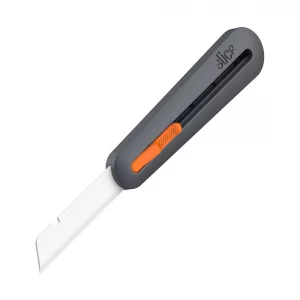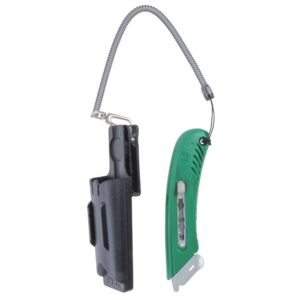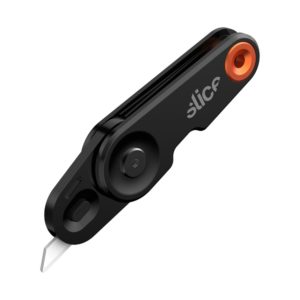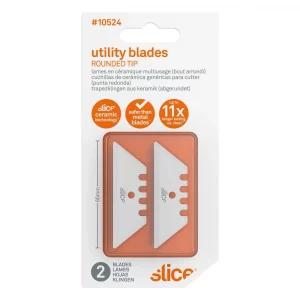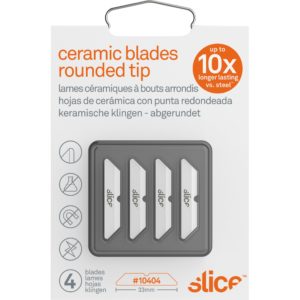Summary – Ceramic blades are 10x sharper than steel and are safer to operate with Slice’s patented finger-friendly® design. Household and industrial use cases benefit from increases safety and reduced costs from ceramic blades. Many still prefer steel blades for its reliability in industrial applications.
The Benefits of Ceramic Blades on Safety Cutters
Ceramic blades are stronger, safer, and and more durable than steel blades.
- Ceramic lasts 11x longer than steel
- Ceramic blades can reduce laceration injuries by 70%
- Ceramic blades never rust
Ceramic kitchen knives differ from the ceramic blades found on Slice knives. For one, Slice safety cutters have thicker blades so they don’t bend and are more reliable over extended use.
And if you’ve dropped a ceramic kitchen knife, you were probably surprised to see it shatter into millions on pieces. Well, Slice ceramic blades don’t shatter like thin ceramic blades.
The Benefits of Steel Blades on Safety Cutters
Steel blades are as old school as the first box cutter ever invented over a century ago. Now, there’s more competition on the market but steel blades are still king for many. From an old-school grocery store hand tool to the newest and greatest Pacific Handy Cutters, you can depend on steel to reliably perform.
- Dependable, there’s a reason steel has been used for over a century
- Cost-effective steel blades are 5x less expensive than ceramic
- Reliably sharp, easily change out to a new steel blade when needed
Plus, many steel blades are manufactured in the United States with American raw materials leading to a higher quality blade than low-cost competitors in China and elsewhere.
The Downsides of Steel Blades on Safety Cutters
Stainless steel is a softer material than ceramic and dulls more rapidly than ceramic. Steel blades are honed to a precise thickness to maximize their cutting power, but this also makes them a safety hazard. Stainless steel is certainly not finger-friendly and is easy to lacerate yourself if you lose focus.
If you can avoid cutting yourself, then steel blades are as effective as they were a century ago. You may benefit from choosing a safety cutter with built-in safety features like the S5 Safety Cutter, with a sharp steel blade and design features to reduce injury.
Can Ceramic Blades Cut Through Clamshell Packaging?
Yes! Slice ceramic blades can cut through thick plastic clamshell packaging easily. With the enhanced safety features of ceramic, you are at less risk of damaging yourself too.
Plastic clamshell packaging isn’t a problem for steel blades either, but you may want to avoid steel blades for household use. The last thing you want is a child accidentally cutting themselves with a steel blade. Ceramic blades don’t eliminate the risk of laceration injuries but they greatly reduce them.
Take a look at the demonstration below to see how easily ceramic cuts through the most difficult packaging materials on the market. Even the smallest ceramic blade can cut through the thickest plastic packages.
Conclusion – Ceramic vs. Steel Blades on Safety Cutters
Your choice between ceramic and steel safety cutters shouldn’t be solely dependent on cost.
Ceramic cutters can justify their increased initial investment by lasting up to 10x longer than steel cutters.
However, steel blade cutters provide reliable cutting power that’s made them a staple for the last century.
Innovative Features in Today’s Safety Cutters
Explore the many benefits of purchasing utility knives in bulk—from significant cost savings and enhanced workflow to environmental sustainability. This guide covers everything from the types of knives, essential buying tips, top brands, and effective usage strategies to safety practices and maintenance advice, helping you make the most informed decision at SafetyCutters.net.
The Ultimate Guide to Buying Bulk Utility Knives
Explore the many benefits of purchasing utility knives in bulk—from significant cost savings and enhanced workflow to environmental sustainability. This guide covers everything from the types of knives, essential buying tips, top brands, and effective usage strategies to safety practices and maintenance advice, helping you make the most informed decision at SafetyCutters.net.
Unleashing the Precision: Exploring the Benefits of Ceramic Scalpels
Introducing Slice Ambidextrous Ceramic ScissorsAs a professional in any industry, having the right tools can make all the difference. When it comes to cutting and
Discover Convenience and Safety: Introducing Slice Ambidextrous Ceramic Scissors
When it comes to warehouse operations, safety should always be a top priority. The use of safety cutters is an effective way to enhance warehouse safety.
Carpet Knife vs Utility Knife: Unraveling the Key Differences
Carpet knives, defined by their sharp, pointed blades ideal for soft flooring materials, contrast with the broader versatility of utility knives, which can address a myriad of cutting tasks.
Why Box-Cutter Gloves Are a Must-Have for Workplace Safety?
This article explores the importance of box cutter gloves in maintaining a safe work environment and providing reliable cut-safe protection.

